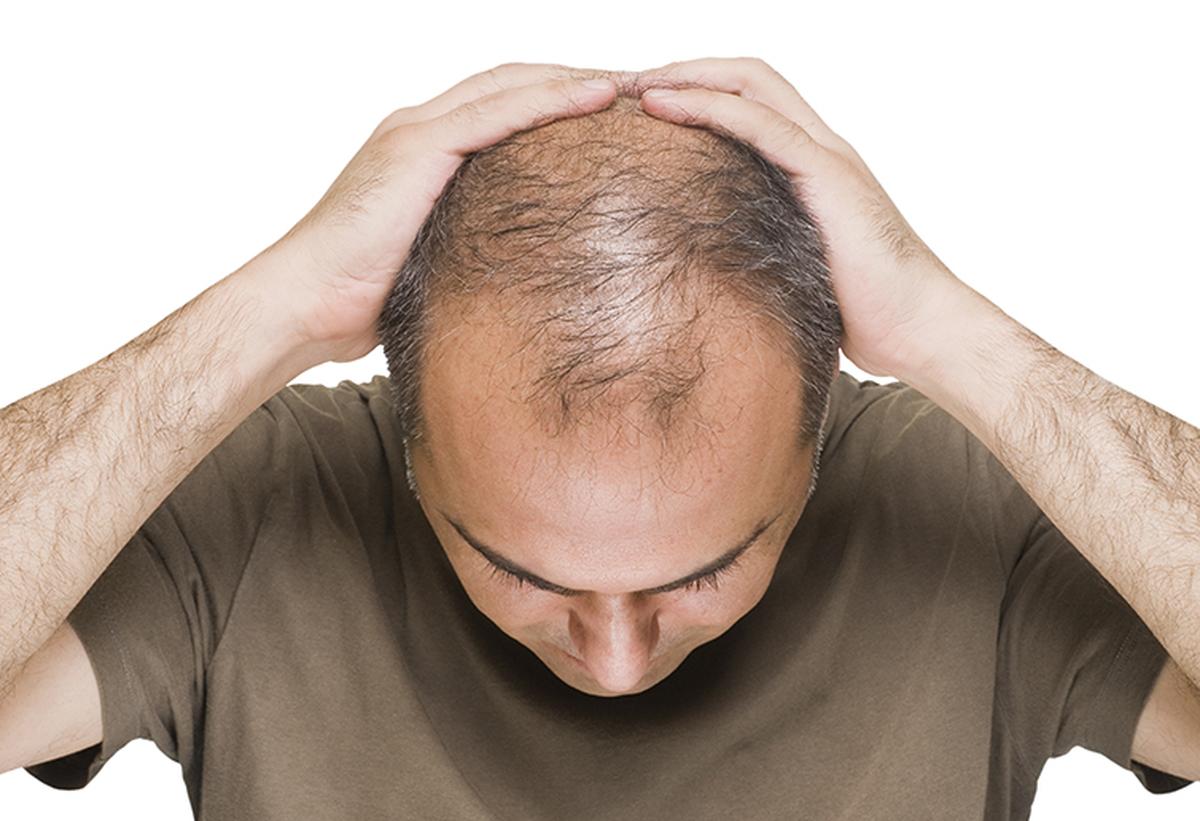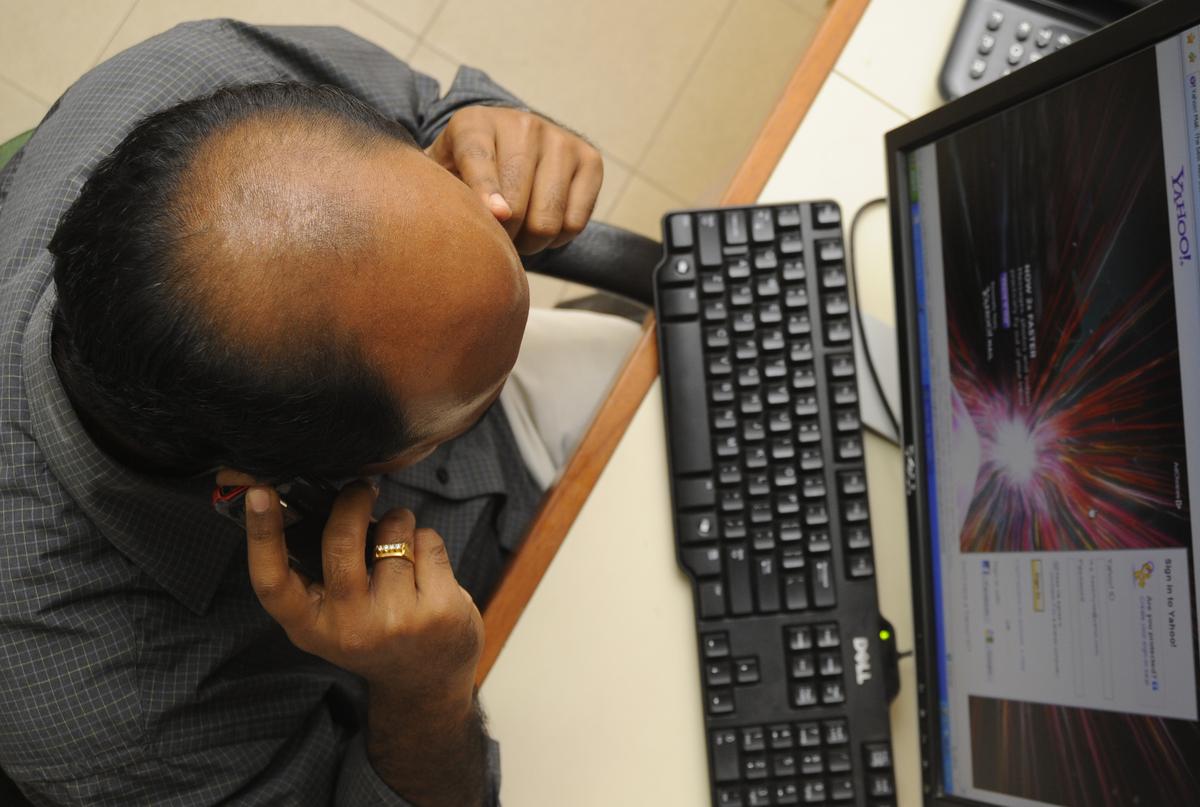It began, as many urban tragedies do, in front of a mirror.
Soft morning light filtered through a flat in Hyderabad; the hum of an electric toothbrush, the faint smell of caffeine and moisturiser in the air. And there, reflected in the mirror, a small circle of scalp — shiny under the cabinet light in the washroom.
For 27-year-old Sharan, that shiny patch had become a quiet obsession. Gym at 6 a.m., meal prep by 8 a.m., hair serum by 9 a.m. — his life ran on discipline. But no routine could outwit biology. He could manage his calories, but not his hairline. It wasn’t vanity; it was the quiet grief of losing control.

Then came the sting: a faint burn at the crown of his head that spread like wildfire by morning. When Sharan looked in the mirror, his scalp was an angry red; the kind of red that screams mistake.
He didn’t know it yet, but he had just joined the growing ranks of men being lured by India’s booming black market of miracle hair cures — a world where desperation meets deception.
Just three days earlier, an Instagram ad had found him at his most vulnerable — late at night, under the blue glow of his phone, scrolling through his quiet desperation. “15-day miraculous hair regrowth,” the video claimed, showing men whose patchy crowns had turned into lush pastures. The video had garnered nearly 32,000 likes and 1,000 comments with the caption stating: “Instant youth. Confidence restored. Scientifically proven.”
Within minutes, curiosity outweighed caution. A few messages later, he was invited to a “consultation” in Uppal Bhagayat, on the eastern edge of Hyderabad in April this year. The ‘clinic’ turned out to be a makeshift tent on a dusty lane near the Uppal Metro station. A flexi banner fluttered overhead: ‘Guaranteed Regrowth or Money Back’. Behind a folding table stood Harish from Rajanayak thanda in Suryapet district, 150 kilometres away — a salesman in a bright white shirt and confidence thicker than his product’s fragrance. “No side effects,” he said, handing Sharan three unlabelled bottles filled with a pungent, water-like liquid. “You will see new hair in 15 days. Guaranteed.”

Sharan paid ₹1,000, took home the bottles and followed the handwritten instructions. By the second morning, his scalp tingled. By the third, it burned. By the fourth, he was sitting across from his dermatologist, who took a deep sigh and said: “This isn’t treatment. It is trauma”.
“It felt acidic,” Sharan recalls, running his palm over his scalp. “My flatmate said I looked like I had been barbecued. That’s when I realised, better bald than burnt.”
Across town, Ravi Kumar, a 34-year-old businessman, underwent a similar experience at the camp. “I thought this was finally going to work. Turns out, the only thing that grew was our disappointment,” he says.
By the time police arrived, Harish’s pop-up at Uppal had descended into chaos. Hundreds of men — engineers, salesmen, students — waited under the sun, their scalps slick with dubious oil. Some were angry, others embarrassed. A suo motu case was booked.
Scalps and scams
Across the country, hundreds of men are learning the hard way that the pursuit of hair can cost far more than pride. From pop-up clinics to social media “experts”, a growing industry of quack cures and false hope is preying on male insecurity and burning more than just scalps.
Over the past two years, hair-related scams have left victims defrauded and, in some cases, even dead. In Uttar Pradesh’s Sambhal, celebrity hairstylist Jawed Habib and associates faced 32 FIRs in mid-October for allegedly duping investors through Follicle Global Company.
In Meerut, a man was arrested last December for selling “miracle” hair growth oils that caused severe allergic reactions. In Chennai, one person lost ₹70 lakh to a quack operating without medical qualifications in July this year. Two months before that, two engineers in Kanpur died within 48 hours of botched hair transplant surgeries carried out by a dentist masquerading as a specialist.

From obsessively checking mirrors to experimenting with miracle oils and dodging pop-up clinics, the journey for most men struggling with baldness can be stressful, costly and even dangerous. Representational image.
| Photo Credit:
Getty Images/iStockphoto
Hair loss is more than a medical condition. It is an existential one. For marketing executive Sandeep, 29, his reflection has become a cause for concern: “I can’t stop checking windows or mirrors. Even a faint glimpse of my head can ruin my day.” His mornings begin with imported serums, his afternoons under hats, and his nights spent doom-scrolling through videos of miracle oils brewed in basements.
Debu Sinha, 28, a private company employee, treats social and dating life like a strategic operation. “I always choose seats/chairs where fans or AC vents don’t blow over my head,” he says. “People think I am chivalrous but I am just hiding my bald patch.”
Barbers across Hyderabad have noticed a new generation of customer — not someone looking for a haircut but for hope. “We tell them straight: your hair is thinning and they give us a helpless smile,” says Srinivas Rao, a salon owner in Kanajiguda with over two decades of experience. “But this problem has become far more common than it was even five years ago.”
S. Sridevi, a clinical psychologist, notes that male patients with hair loss often show anxiety and social avoidance. “A 26-year-old skipped his college reunion because he thought everyone would make fun of his thinning hair. Another stopped going to the gym, which was his safe space, worried that fluorescent lights would betray him,” she says.
Amit Varma, who counsels men on identity issues, points out that baldness can undermine masculinity, youth and professional confidence: “Some men begin avoiding interviews and social events entirely.”

In one extreme case, a 27-year-old banker woke up at 5 a.m. daily to apply imported serums, believing that one missed day would undo months of progress. By the time he sought therapy, he was exhausted, anxious and ashamed, Dr.Sridevi recalls.
And yet, the scams keep growing faster than the hairlines they promise to restore.
Last year, Wakil Salmani, a barber-turned-influencer from Delhi, was arrested for running “miracle regrowth camps” across multiple States across India. His “organic follicle stimulator” sent several men to the hospital.
In Punjab’s Sangrur this March, an unauthorised hair treatment camp caused a serious eye infection outbreak among at least 60 men, leading to hospitalisations.
In Meerut, three operators ran a travelling “regrowth mela” in December last year, charging ₹300 per entry and leaving behind a trail of burned scalps and dashed hopes.
Each case follows a pattern: social media hype, a temporary tent, long queues of anxious men and the silence that follows when it all goes wrong. Embarrassment keeps most victims from reporting it. In a culture where masculinity is supposed to be unshakable, admitting vulnerability, even to the police, often feels like defeat.
The chaos in Uppal still haunts Ravi Kumar. “Men were applying oil on the spot, filming themselves for proof. Some scalps had already turned red. Nobody wanted to leave. Hope makes fools of us all.”
Science vs. hype
Science, of course, is not as dramatic. Deepika Sanbal, consultant dermatologist at Apollo DRDO, explains that male pattern baldness, or androgenetic alopecia, is largely hereditary. “We can slow it, manage it and even reverse it in some cases. But it requires diagnosis, consistency and realistic expectations.”
Legitimate treatments, she says, include finasteride, minoxidil, PRP therapy and hair transplants. “But social media has replaced medicine with marketing. Men want miracles, not maintenance. They end up damaging their scalps, sometimes permanently,” she adds.

The cost of medical treatment also fuels desperation. PRP therapy ranges from ₹70,000 to ₹1.5 lakh while oral medications demand months of disciplined use.
Men cope in ways that swing between inventive and absurd. Sinha plots seating arrangements as if it were tactical warfare while Sandeep’s growing hat collection is his arsenal. “I call them my emotional helmets,” he jokes.
Humour, too, is a quiet rebellion. Stand-up comic Srujan mines baldness for laughs. “One friend mixes onion juice and garlic paste and calls it Ayurvedic PRP,” he says. “The smell could kill romance faster than hair loss ever did.”
Psychologists say embracing baldness often beats the most expensive lotions. “Men who accept it show higher self-esteem,” says Dr. Varma. “It is not the hair; it is the illusion of control that they need to let go of.”

This image is used for representational purposes only.
| Photo Credit:
The Hindu
Society, however, rarely makes it easy. Bollywood heroes rarely go bald unless the plot demands tragedy. Cricketers endorse shampoos. Dating apps favour a “full hair” aesthetic. The message is clear: baldness is a problem to solve, not a reality to accept.
That pressure seeps into every mirror, every selfie and every conversation. In cities like Hyderabad, hair clinics have become the new gyms: aspirational spaces promising transformation. Some men have even gone to the extent of borrowing money for hair transplant, treating it as an investment in confidence.
Yet, a counter-movement is quietly taking shape. Influencers proudly flaunt shaved heads and well-groomed beards, normalising baldness as a style rather than a flaw.
“It is like the beard revolution,” one Reddit user notes. “Bald is the new bold, if you carry it right.”
For Sharan, acceptance came slowly. “At some point, you stop bargaining,” he says. “I threw away the fake oils, the supplements, and even the hair fibres. I deleted the miracle advertisements from Instagram. Now, I just invest in good caps and better jokes.”
Sinha has followed suit. “I still avoid ceiling fans, but now it is a running joke. You can’t fight genetics forever, so you might as well laugh.”
Even women notice the shift. Priya Reddy, 31, who is dating a man with receding hairline, shares, “He became withdrawn at first. But when he started talking about it openly, everything changed. Confidence looks better than a head full of hair.”
Confidence beyond follicles
Hair, fragile as it is, holds enormous sway over identity. It grows, it falls, and somehow dictates how men see themselves. The crisis is not follicular; it is emotional.
Dr. Sridevi believes education is the only real remedy: “Appearance doesn’t define worth. Quick fixes are dangerous. Acceptance is healing. Therapy helps men detach self-image from hair image.”
Her clinic runs group sessions for young professionals united by one fear: losing something bigger than hair.
Sharan, now comfortably bald, sometimes passes the clinic. “Funny how something that caused so much pain now makes me laugh,” he says. “I used to think losing hair meant losing confidence. Turns out, confidence was the only thing I needed to grow back.”
He grins, adjusts his cap, and heads into the society — a man at peace with the mirror. “Hair today, gone tomorrow,” he quips. “But at least my sense of humour stayed.”
In the end, the mirror no longer dictates their worth, at least for some of them. Sharan, Sinha, Sandeep and countless others have learned that the chase for perfect hair is less about follicles and more about control. Some find it in humour, some in acceptance, some in simply moving on. The scalp may be bare, but confidence, it turns out, is something that can grow anywhere.











Leave a Reply